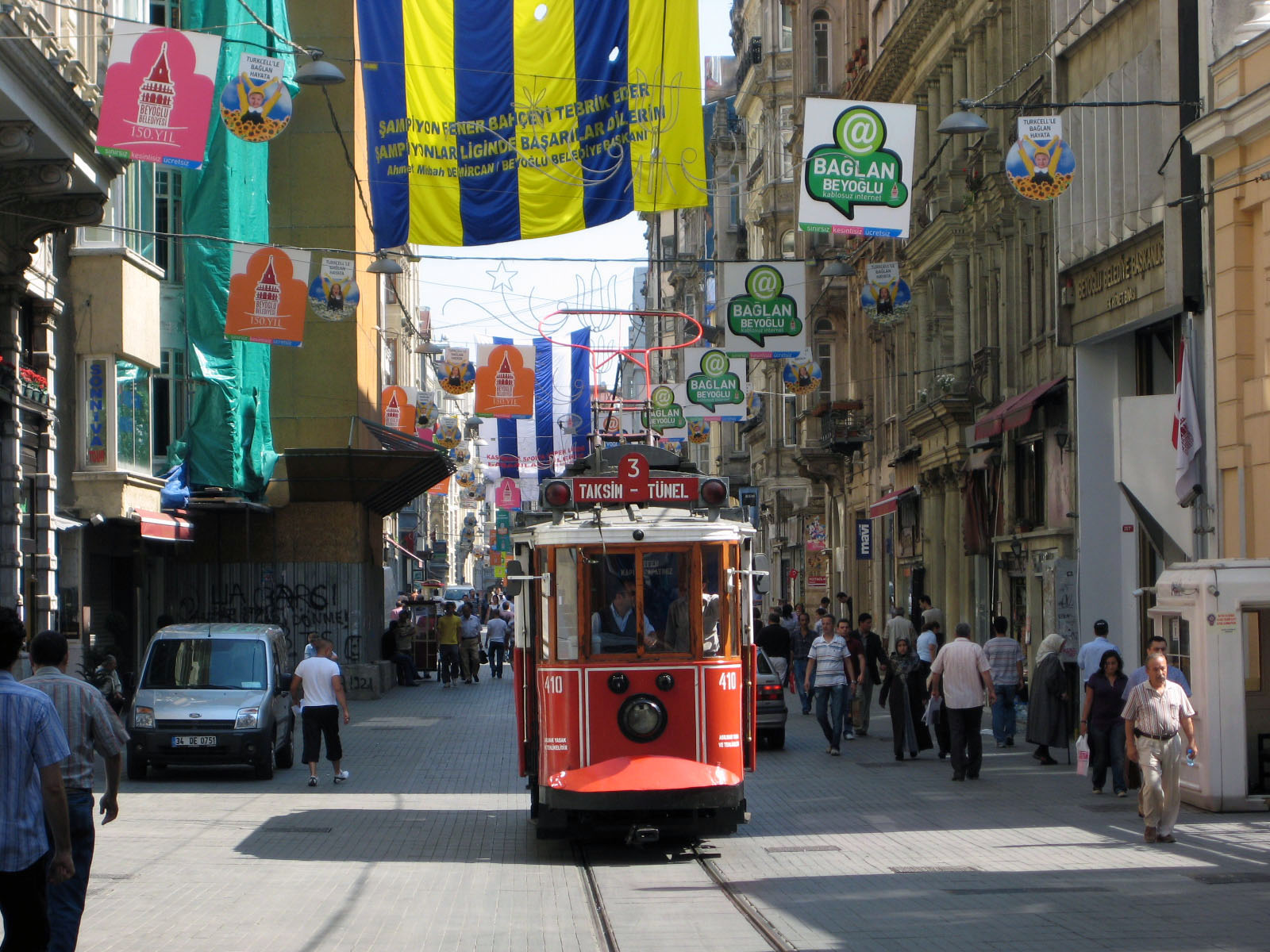 We’re staying in the old Beyoglu District, near the Istiklal pedestrian zone, about a 20 minute walk from Taskim Square. This is the old Pera, once a wealthy suburb across the Bosphorus from the Old City. It’s now a revitalized section of Istanbul, filled with grand avenues of shops and cafes and narrow medieval streets filled with restaurants, art shops and cafes. It’s very European and reminds us a lot of Paris and Rome.
We’re staying in the old Beyoglu District, near the Istiklal pedestrian zone, about a 20 minute walk from Taskim Square. This is the old Pera, once a wealthy suburb across the Bosphorus from the Old City. It’s now a revitalized section of Istanbul, filled with grand avenues of shops and cafes and narrow medieval streets filled with restaurants, art shops and cafes. It’s very European and reminds us a lot of Paris and Rome.
There is a old 19th century trolley that runs down the center of the Istiklal from Taskim Square to the Galata lookout tower, the 14th century Genovese tower built after the Fourth Crusade in 1204. The crusade was on it’s way to Jerusalem but Constantinople (Istanbul) was closer and had more loot. Since most of the crusaders were just in it for the booty, this was as far as they needed to come. All important buildings were sacked, and the best architectural and artistic treasures shipped back to Venice.
 Since the Doge, Enrico Dandolo, of Venice organized the sack of Constantinople so he got to claim most the treasure. It included the Statue of the Tetrarchy and the four bronze horse statues that once stood at the top of the Hippodrome of Constantinople. These pieces are still in Venice, mostly at the Basilica San Marco. However, Dandalo never really got to fully enjoy the treasures. He was totally blind. In 1205, he led another ‘Crusade” into Bulgaria but this time he was killed. His body was buried in the Byzantine Hagia Sophia Church, in Constantinople. When the Turks reclaimed the city in 1453, they tore up the grave and disposed of the body. For some reason through, they left the grave marker when they converted the Hagia Sophia Church into the Ayasofia Mosque.
Since the Doge, Enrico Dandolo, of Venice organized the sack of Constantinople so he got to claim most the treasure. It included the Statue of the Tetrarchy and the four bronze horse statues that once stood at the top of the Hippodrome of Constantinople. These pieces are still in Venice, mostly at the Basilica San Marco. However, Dandalo never really got to fully enjoy the treasures. He was totally blind. In 1205, he led another ‘Crusade” into Bulgaria but this time he was killed. His body was buried in the Byzantine Hagia Sophia Church, in Constantinople. When the Turks reclaimed the city in 1453, they tore up the grave and disposed of the body. For some reason through, they left the grave marker when they converted the Hagia Sophia Church into the Ayasofia Mosque.
We very much enjoy walking through the Istiklal and the neighborhoods of the Pera. If we got too tired, there is always a nice small café or bar to grab a deliciously cold Efes beer.
Enjoying a beer on a hot afternoon, or a glass of wine or raki is one of the great pleasures of Turkey, which seems strange in this predominantly Muslim country. But the Turks consider themselves to be modern Muslims in every sense. All weddings are secular. Ataturk banned all religious interference in the 1930’s. Most of the people dress in western clothing and they’re known to enjoy a good drink or two or three or four.
In the 13th century, a cult surrounding the mystical, philosopher Bektashi sprang up in Cappadocia and became the spiritual guidance of the Janissary corps, the elite fighting machine of the Sultans. The Bekstashi and the Janisarries liked to drink and when the Ottomans accepted Muslim as their religion these elite fighters couldn’t quite wrap themselves around the “non alcohol” rule. The Bektashis decided to find a loophole. They read into every word of the Koran until they found the sentence, “you will not partake of one drop of alcohol”. That was all that was needed. Hacibektash Veli, the leader of the sect approached the Sultan and told him of his discovery. He poured a glass of alcohol and recited the line about not partaking of one drop. He then dipped his finger into the glass and lifted up one drop. Flinging the “drop” to the floor he exclaimed, “there is the one drop I shall not partake of”. The Turks have been drinking ever since. Many of them will still dip their finger in the glass and flick the evil drop to the floor.
Our walk to the Old City takes us over the Galata Bridge, which has been rebuilt a few times over past couple of centuries. This version of the Galata bridge was completed in 1994. The Tram runs down the center, there are great views from either end and the railings on both sides of the bridge are always filled with Istanbullus dropping fishing lines into the Bosphoros. On the hot day we crossed the bridge, Gretchen saw an Istanbullu strip off his shirt and dive off the railing into the dark waters below.
There were plans to a bridge on this location going back to 1502 when Sultan Beyazid II requested architectural plans from Leonardo Da Vinci. The Da Vinci bridge had a 240 meter span, but the Sultan didn’t like it. A smaller version of this bridge was eventually built in Norway by Norwegian artist Vebjorn Sand about 7 or 8 years ago. Michaelangelo also submitted a design the Beyazid II, but he was also rejected. And so the first bridge never got built till around 1845.
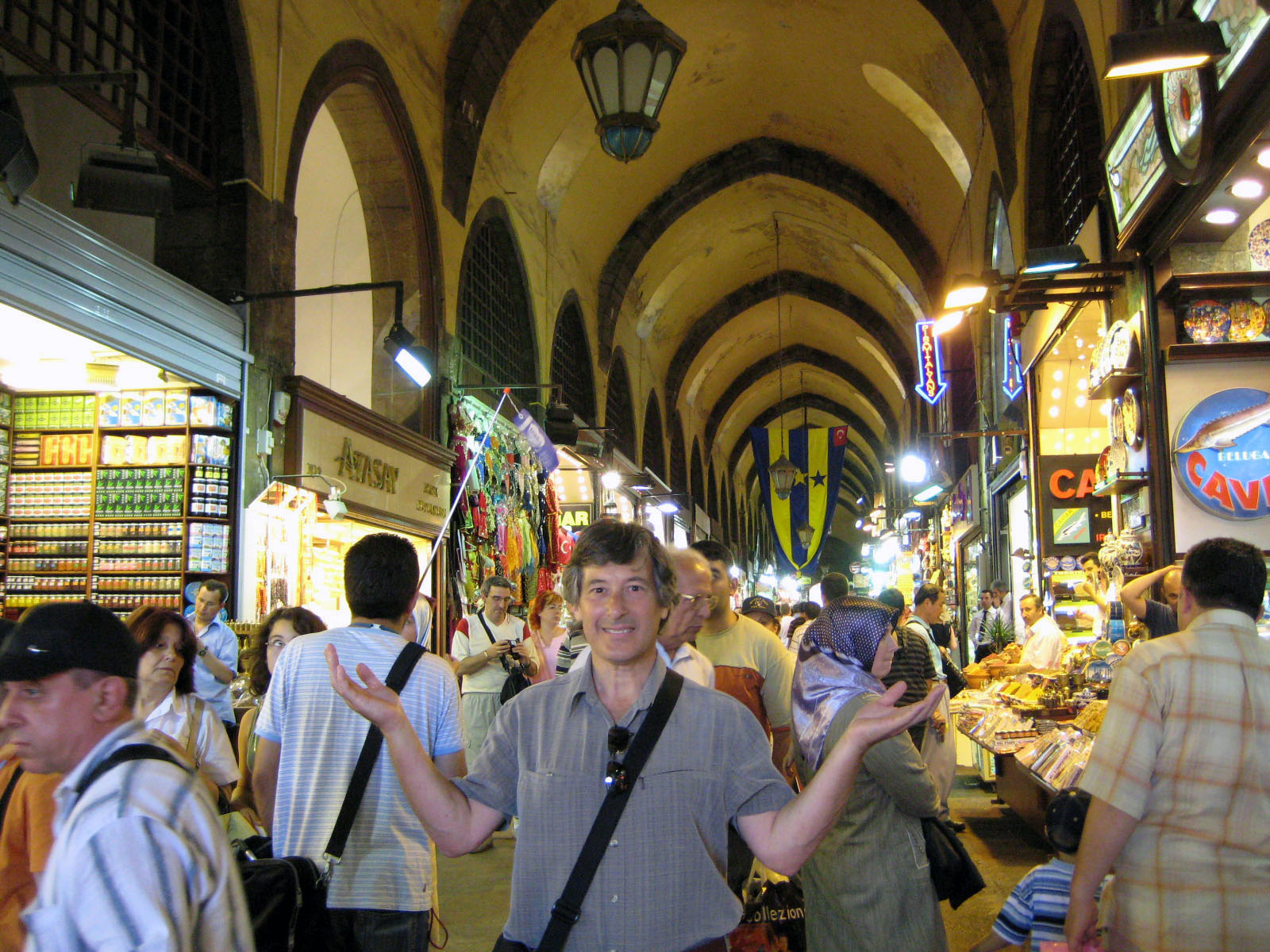 Across the bridge is the Eninonu section of the city and the 17th century Egyptian Spice Market, one of our favorite Bazaars. It’s smaller then the Grand Bazaar. We must have caught it on a slow day. The last time we were here it was just before sundown on the day before Ramadan and we were literally carried away by the flow of people. Summer is easier to get around and the pace of life is much slower and this time everyone was casually strolling past the colorful spices, dried fruit and Turkish delight. There’s also a clothing market outside the walls of the Spice market. In fact, it goes all the way over to the Grand Bazaar, it’s one long line of tables selling everything from t-shirts, jeans, 5 pair of socks for 1 turkish lira, household products, beauty supplies and hand guns (they don’t sell the ammunition, just the guns).
Across the bridge is the Eninonu section of the city and the 17th century Egyptian Spice Market, one of our favorite Bazaars. It’s smaller then the Grand Bazaar. We must have caught it on a slow day. The last time we were here it was just before sundown on the day before Ramadan and we were literally carried away by the flow of people. Summer is easier to get around and the pace of life is much slower and this time everyone was casually strolling past the colorful spices, dried fruit and Turkish delight. There’s also a clothing market outside the walls of the Spice market. In fact, it goes all the way over to the Grand Bazaar, it’s one long line of tables selling everything from t-shirts, jeans, 5 pair of socks for 1 turkish lira, household products, beauty supplies and hand guns (they don’t sell the ammunition, just the guns).
By the end of the Venitian rule, the Italians had pretty much bled the city dry. It was almost bankrupt. When Mehmed “the conqueror” took it back in 1453, he used whatever resources he could get and rebuilt it as the capital of the new Ottoman Empire. He created the Grand Bazaar, the Topkapi Palace, Mosques, schools, public baths. Suleiman (Solomon) the Magnificent expanded the glorification of the city.
1520 to 1566 were the Golden days on the Golden Horn. Suleiman was the defining Sultan of the empire, loved by his people and feared by his enemies. He built over 300 mosques and monuments throughout the empire. He practiced religious tolerance towards all and opened the doors of the city to Jews who were expelled from other countries, declaring Jews are welcome to be Ottoman citizens; his personal physician was Rabbi Moshe Hamon. There’s still a very large jewish community in Istanbul. Suleiman was a poet and his love for his wife Roxolana is legendary stuff. Unfortunately, Roxolana became the Ottoman version of Catherine De Medici, manipulating the courts to put her favorites on the throne. Her choices weren’t the best choices for the empire.
Suleiman’s son, Selim II was more interested in drunken orgies and became known as Selim the Sot. His son Murad III spent all of his time watching his 1200 most slave women frolic around naked in the royal pool. His son Mehmed III had his 16 brothers strangled on the day of his succession. By 1640, Ibrahim the mad pretty much signaled the end of the Ottoman Empire. He was pretty crazy when he took the throne, but things got much worse. He had an obsession for really fat women and even gave one of them a governorship in the kingdom. People accepted his idiosyncrasies for a while; feeding gold coins to the fish in the Palace Pool could have been looked on as charming. But when he started shooting down his ministers from the walls of the Topkapi Palace the big alarm went off. He was finally overthrown after he drowned all 280 women in his harem.
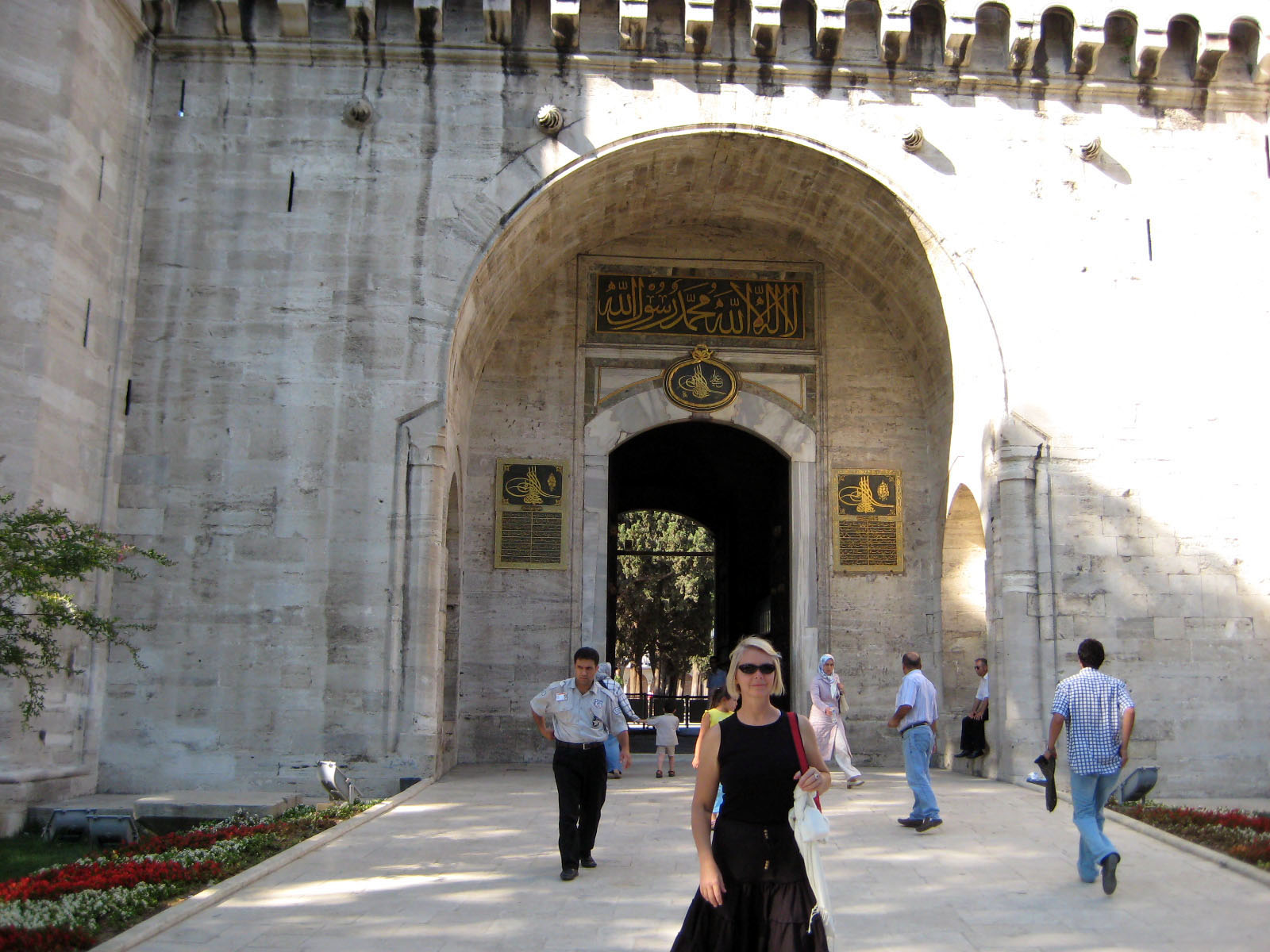 Topkapi, the sprawling palace of the Ottoman Sultans is built around 4 courtyards, the first one you enter was used for executions. The marble execution block is still there. The Sultans lived in Topkapi Palace till the 19th century. By then, they found it too dated and changed the royal location to the Neoclassical, Baroque, Rococo Dolmabahçe Palace overlooking the Bosphoros.
Topkapi, the sprawling palace of the Ottoman Sultans is built around 4 courtyards, the first one you enter was used for executions. The marble execution block is still there. The Sultans lived in Topkapi Palace till the 19th century. By then, they found it too dated and changed the royal location to the Neoclassical, Baroque, Rococo Dolmabahçe Palace overlooking the Bosphoros.
Most of the rooms of the Palace are now given over to the display of the fabulous wealth of carved and inlaid thrones and enormous jewels. The emerald embellished Topkapi dagger was made famous in the 1960s film Topkapi staring Melina Mercouri, Maxmillian Schell and Peter Ustinov. The very large (86 carat) “Shoemaker’s” diamond in the Palace display cases was found in a garbage dump and sold to a spoon maker for three spoons. It’s now back in the royal Palace.
The collection also includes some “authentic” (wink wink) relics including the right hand of John the Baptist and an entire collection of Mohammed. As the story goes, when the Turks captured Arabia, they took all the holy relics of Mohammed; the cloak, the teeth, the beard, the sword, the staff, the footprint and a few documents. Supposedly, whoever holds the holy relics of Mohammed holds the central position of Islam. Which means that Istanbul should be the Vatican of Islam. One more thing the Muslims can’t agree on.
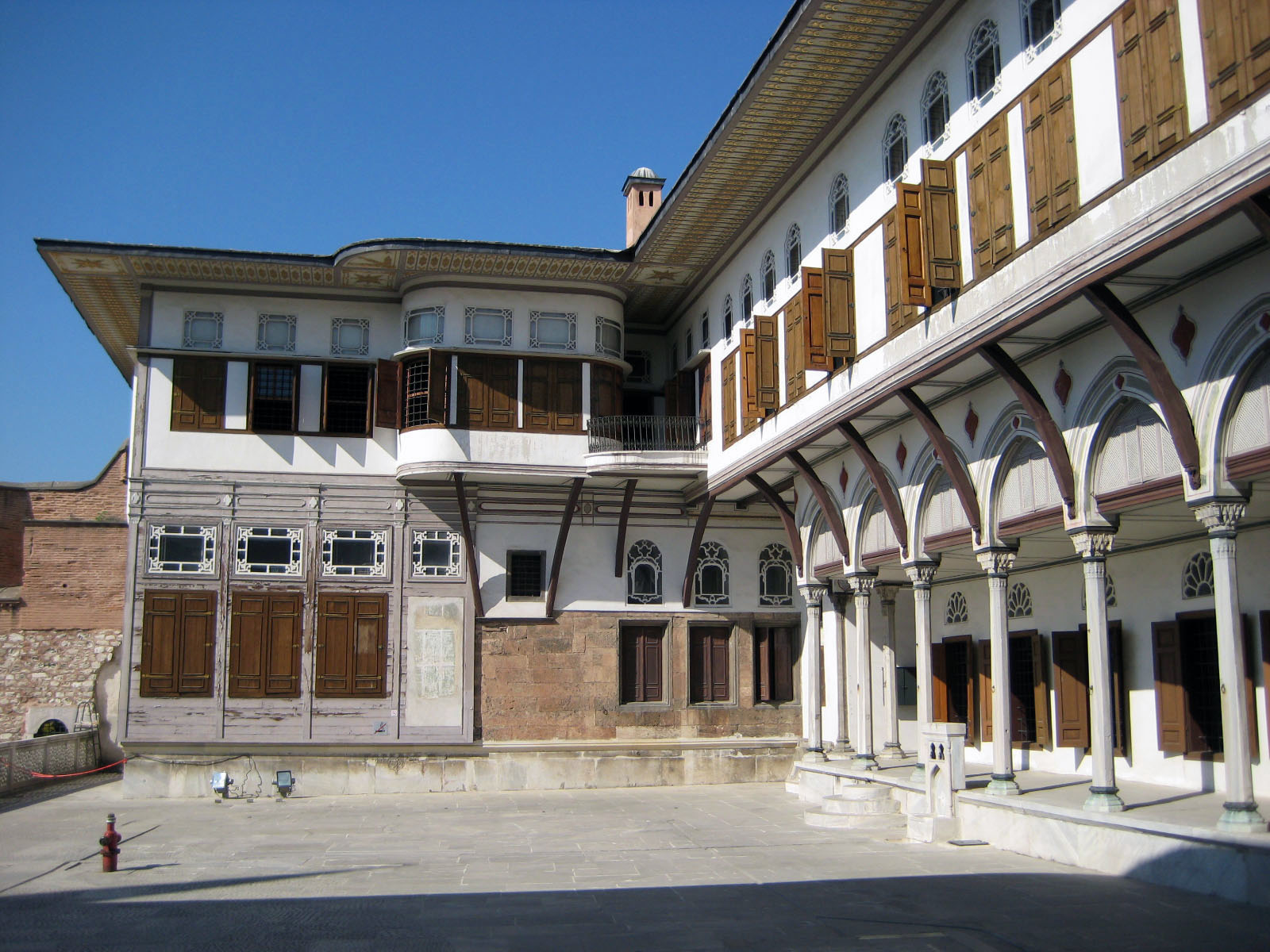 The Harem, mostly designed by Sinan, the greatest Ottoman architect of the 16th century, includes about 300 rooms, but only about 20 of them are open to the public. These were the quarters for the Queen mother, the young princes and the eunuchs who ran the Harem. At any given time there were close to 300 women living there. I have no idea of how many eunuchs there were.
The Harem, mostly designed by Sinan, the greatest Ottoman architect of the 16th century, includes about 300 rooms, but only about 20 of them are open to the public. These were the quarters for the Queen mother, the young princes and the eunuchs who ran the Harem. At any given time there were close to 300 women living there. I have no idea of how many eunuchs there were.
The Sultan’s Mother’s chambers are large, gaudy and faded, but then again, they were built over 500 years ago. The bath area of cool white tiles evokes a charming time of maidens being bathed by large male eunuchs. There were also special rooms for the Sultan, one with a waterfall fountain that would drown out and conceal conversations the Sultan would have with his most trusted advisors. They were all paranoid of spies.
The favorite concubines lived in a separate wing over a large swimming pool; the same pool Mad Ibrahim drowned all 280 of his harem women. This wing was also connected to the Sultan’s chambers along the Golden corridor. There are two stories here. One that the Sultan used to throw gold coins in the corridor of the women of the harem, the other was that if the Sultan like the services of the concubine, she was golden. Take your pick, they’re both pretty good.
By the beginning of the 17th century, the bloated and stagnant empire endured loss after loss to the Austrian-Hungarian empire on the rise. And so history changed hands one more time. The final sultan of the Ottoman Empire, Mehmed VI was crowned on July 4th 1918, but he lasted less than 4 years. There wasn’t much of an empire left. When the Ataturk nationalists took over, Mehmed VI lived the rest of exiled life in Sanremo, on the Italian Riviera.
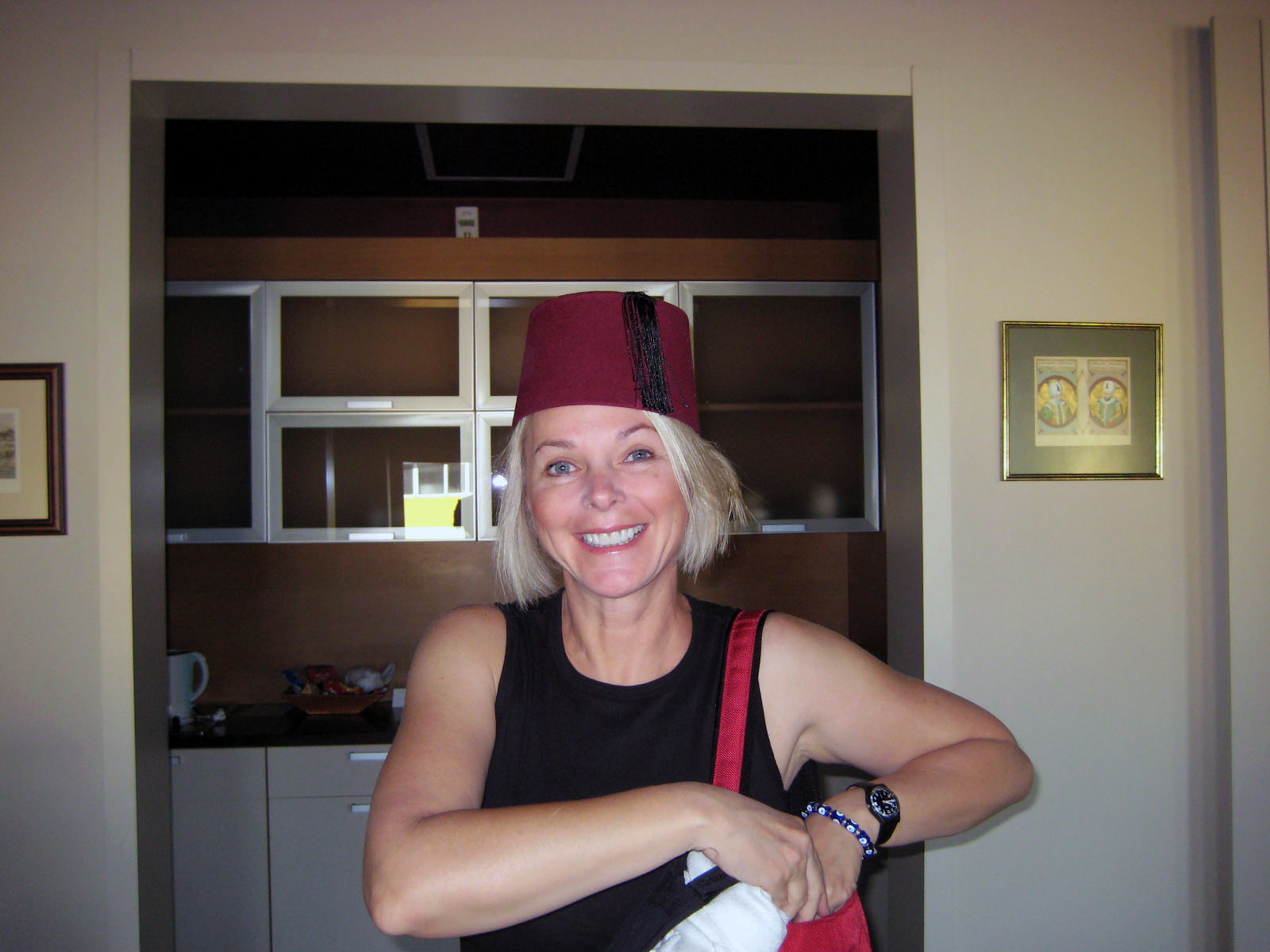 When Kamal Ataturk took over the country in the 1923 he really tried to update the country and remove the old vestiges of the Otoman Empire. He introduced the western calendar, the 24hr clock and the latin alphabet. He actually traveled through the country with a large slate blackboard to show the people the new words in person. He banned polygamy and women were given the right to vote in 1934. In 1935 he gave people last names (instead of son of …..) He banned the Fez which had been the chosen headgear for close to 100 years, and in 1930, he changed the name from Constantinople to Istanbul.
When Kamal Ataturk took over the country in the 1923 he really tried to update the country and remove the old vestiges of the Otoman Empire. He introduced the western calendar, the 24hr clock and the latin alphabet. He actually traveled through the country with a large slate blackboard to show the people the new words in person. He banned polygamy and women were given the right to vote in 1934. In 1935 he gave people last names (instead of son of …..) He banned the Fez which had been the chosen headgear for close to 100 years, and in 1930, he changed the name from Constantinople to Istanbul.
“Istanbul was Constantinople
Now it’s Istanbul, not Constantinople
Been a long time gone, Constantinople
Now it’s Turkish delight on a moonlit night”
(words and music by Jimmy Kennedy and Nat Simon)
Original recording; The Four Lads , August 12, 1953
The last time we were here, about 13 years ago, there were packs of wild dogs roaming the streets. The wild dogs have been here for hundreds of years. Mark Twain wrote abou them in “Innocent’s Abroad”. They’ve been the bane of Istanbul governing officials and every so often someone comes up with another bizarre solution. The latest is to give them sedatives so they sleep all day, and get lazy and fat. Although we were assured that packs of them still roam the city, we never saw any.
However, we did see lots of merchant sharks. The essence of the Istanbul commerce was summed up perfectly by a young merchant in a small bazaar near the Istiklal. He walked from his shops and said to us, “How can I relieve you of your money?”
The shoe shine men offer free shine no matter what you’re wearing; sandals, sneakers, leather flip flops… They’ll tell you they wish to give you a free shine but as soon as you accept, they’ll tell you they also gave you the special extra shine which of course was not free. The shopkeepers (a good word for them) will keep you in their shop until the only way you can get away is to buy something. The manager of our hotel told us to say “Istem yuodum” and they’ll stop. It just means, thank you I don’t want any, but when you say it to them in their own language, it works.
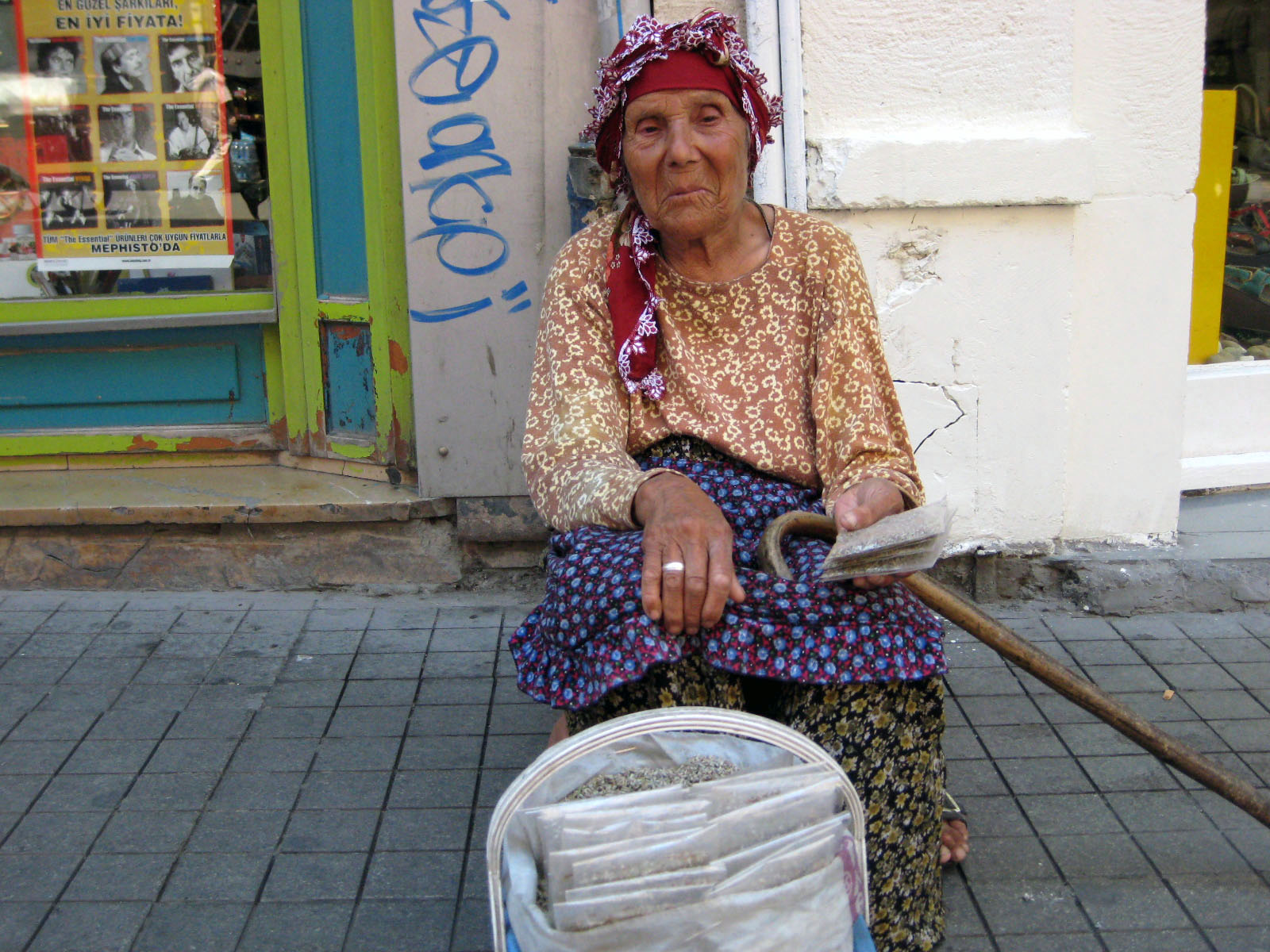 Istanbul these days is wonderful mixture of an old culture giving birth to a new city. Many Delivery men still wear sleds strapped to their backs as they hump heavy crates up the ancient hills. Street vendors are still selling fried mussels, and sesame coated bread along the street and in the markets. Fruit vendors push wheelbarrows up and down the hills, weighing out small bags of fruit with makeshift balance scales and lead weights. Gold and silver merchants sell jewelry by the gram regardless of design or fashion. Women decked out in the latest European fashions are standing side by side with country women in traditional Muslim dress. In the garment district, old men carry two and three 100 pound bolts of fabric on their backs while young men carry trays of tea from the café down the street. It’s a city stuck in old time and clawing to get to the present.
Istanbul these days is wonderful mixture of an old culture giving birth to a new city. Many Delivery men still wear sleds strapped to their backs as they hump heavy crates up the ancient hills. Street vendors are still selling fried mussels, and sesame coated bread along the street and in the markets. Fruit vendors push wheelbarrows up and down the hills, weighing out small bags of fruit with makeshift balance scales and lead weights. Gold and silver merchants sell jewelry by the gram regardless of design or fashion. Women decked out in the latest European fashions are standing side by side with country women in traditional Muslim dress. In the garment district, old men carry two and three 100 pound bolts of fabric on their backs while young men carry trays of tea from the café down the street. It’s a city stuck in old time and clawing to get to the present.
There’s a melancholy over the city known as “huzun”; a mixture of both nostalgia and regret. It’s been here since the fall of the Ottoman Empire. It’s something the Istanbullus have claimed as their birthright and heritage and no matter what happens to this city, the “huzun” will remain. Others are more optimistic.
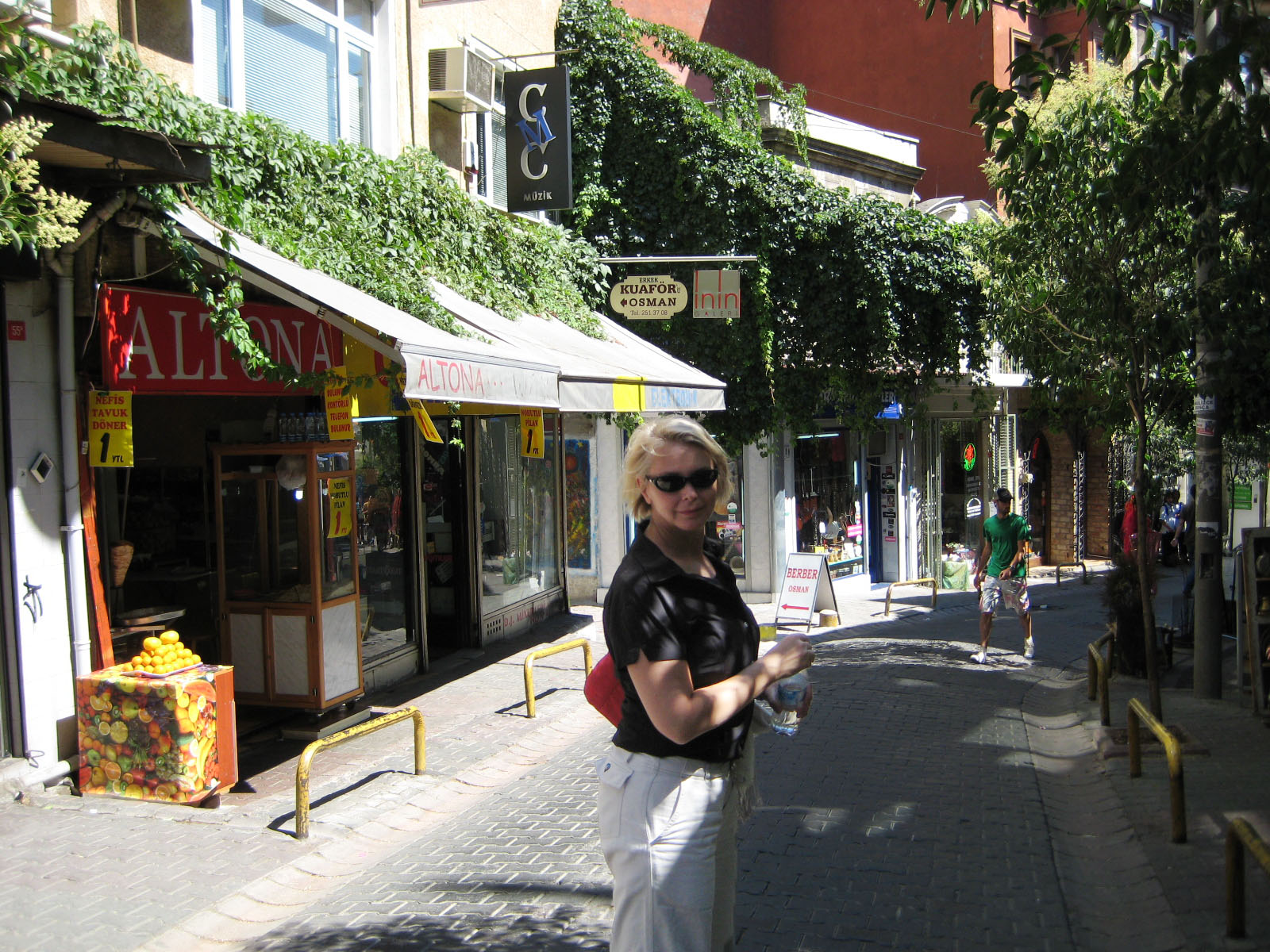 We discovered a new Istanbul on this visit; a city that has taken the charm of the old and molded it into a vibrant stream of cafes and vibrant people. The beautiful colors, smells and sounds of the Old City is great for day trips, but do yourself a favor, stay on the other side of the Bosphoros. I am a big fan of Four Season’s Hotels and there’s a beautiful one right next to the Hagia Sophia. But as soon as you leave the hotel, you’re in the madness of people trying to “relieve you of your money”. The Tram will take you anywhere you want to go in the Old City for 1.30 turkish lira (about $1). The Tram is air conditioned, comfortable and clean. Find a hotel away from the Old City.
We discovered a new Istanbul on this visit; a city that has taken the charm of the old and molded it into a vibrant stream of cafes and vibrant people. The beautiful colors, smells and sounds of the Old City is great for day trips, but do yourself a favor, stay on the other side of the Bosphoros. I am a big fan of Four Season’s Hotels and there’s a beautiful one right next to the Hagia Sophia. But as soon as you leave the hotel, you’re in the madness of people trying to “relieve you of your money”. The Tram will take you anywhere you want to go in the Old City for 1.30 turkish lira (about $1). The Tram is air conditioned, comfortable and clean. Find a hotel away from the Old City.
This is our second visit to Istanbul. The last time we were here we took in a lot more of the sites; Topkapi, the mosques, Hagia Sofia, a boat ride down the Bosphoros, the bazaars, the basilica cistern, Dolmabahche Palace, the old Constantine Walls, the archeology museum, Byzantine churches and so much more. This time, we relaxed and enjoyed the city like Istanbullus. We even went to a movie one night. We weren’t sure if the film was in the original version or dubbed into Turkish so we picked Die Hard 4.0, a film where it really didn’t matter if it was in Turkish or English. And sure enough the plot wasn’t really important (or plausible). Neither was the dialogue. The film was in English with Turkish subtitles. The wierdest thing about the experience was that half way through the film, two geeky Istanbullus broke onto the screen and (we guess) told each other it was time to go to the snack bar and get some treats. Sure enough, the house lights came on and everyone left the theatre. After a 15 minutes intermission, they all returned for the second half.
You must be logged in to post a comment.